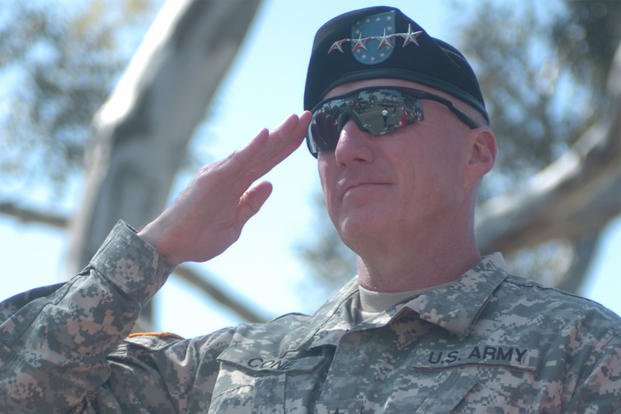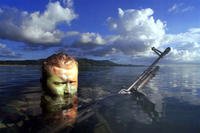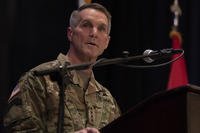WASHINGTON -- The Army's doctrine will change dramatically in the near future as joint leaders develop the operational concept of strategic landpower, Gen. Robert W. Cone said.
One change will be a seventh warfighting function called "engagement," said Cone, who serves as commanding general of the U.S. Army Training and Doctrine Command.
He told those at the Association of the United States Army Aviation Symposium in Arlington, Virginia, on Jan. 15 that the new warfighting function would involve skills used to influence foreign governments and militaries.
Relationships with the Special Operations community that the Army has formed over the past 12 years should be preserved and institutionalized in the strategic landpower concept. So should gains in battlefield intelligence, Cone said.
"Unless we continue to exercise these skills, we will lose them and pay for it again in blood," Cone said.
Joint Task Force
The Strategic Landpower Task Force that Cone presides over is a joint effort with the Marine Corps and U.S. Special Operations Command, or SOCOM. Although Cone is president of the task force, he said the board of directors include Chief of Staff of the Army Gen. Ray Odierno, Commandant of the Marine Corps Gen. James Amos and SOCOM Commander Adm. William H. McRaven.
The task force was formed partly to counter critics who believe "precision strikes" by air and sea power can win a war without boots on the ground.
"While human beings transit air and transit sea, they live on the land," Cone said. "And so your strategic outcomes are going to take place on the land."
Any strategy that relies on only two elements of the joint triad is doomed to be problematic, he said.
Net-Centric Warfare
The Army was captivated from 2001 to 2003 with something called "precision strike" or "net-centric warfare," Cone said. He explained the fundamental premise was viewing an adversary as a "complex, adaptive system."
"You identified critical nodes, and then you essentially used precision strike to take out those nodes that brought about the systemic collapse of the enemy, which resulted in the enemy's capitulation," Cone said.
Before invading Iraq, Cone said he even took part in a "capitulation exercise" at Camp New York, Kuwait. He said many fully expected invading forces to be greeted as liberators.
"How did that work for us?" he asked, adding that the Iraqis "flipped the thing over on its head" and began a bloody insurgency.
"War is fundamentally a clash of human wills," Cone said. "Technology is secondary."
Human Terrain
Before invading Iraq, Cone admitted that he didn't think much of human terrain skills. He said the campaign originally was planned "sort of independent of the people, the culture, the language, the history ..."
But he said 12 years later, after tours in Iraq and Afghanistan, he's the biggest advocate of what the Army has learned about human terrain. He warned that human terrain skills are especially perishable.
"You know what will happen if budgets retract," Cone said. "The first things they will cut are the linguistic skills [and] the human terrain systems."
He said the military has come a long way in battlefield intelligence and human terrain systems over the past 12 years, but he emphasized they must be institutionalized.
"Is there a human domain" in warfare? Cone asked.
The Special Operations Forces community is adamant that there is, Cone said, but the Marine Corps disagrees. He cited the disagreement as an example of the issues the task force is sorting out as it forms its strategic landpower concept.
The joint differences are one reason that the operational concept is taking some time, Cone said, citing that the seven-page Strategic Landpower White Paper took five months to complete.
If it takes time to pave the right path, that's all right, Cone said, because the strategic landpower concept needs to be enduring.
"On the institutional side, I got to tell you, I can't wait to write an operational concept and then change all of [the] doctrine in the coming years," Cone said.
Changes Already Decided
Some decisions already have been made, Cone said. Special operations has been added as an Army competency.
"You'll have combined arms maneuver, you'll have wide-area security and you'll have special operations," Cone said.
To the six warfighting functions, the Army will add another called "engagement," Cone said.
Many of the skills, tasks and systems associated with "influence activities" formerly were clustered under "mission command." But now enough lessons have been learned and the skills are so important, he said the Army will be better served to conceptualize them under a seventh warfighting function.
"The Army's world has been rocked, as we talk about the direction in which we're headed," Cone said. "All of the supporting systems have to come together and understand what the implications are for the future to make sure we treat our soldiers fairly in terms of career management fields, in terms of promotion opportunities and in terms of training options."
Some of these same issues are being addressed by "Force 2025," which Cone said is a "near-term" project under TRADOC.
Want to Know More About the Military?
Be sure to get the latest news about the U.S. military, as well as critical info about how to join and all the benefits of service. Subscribe to Military.com and receive customized updates delivered straight to your inbox.











